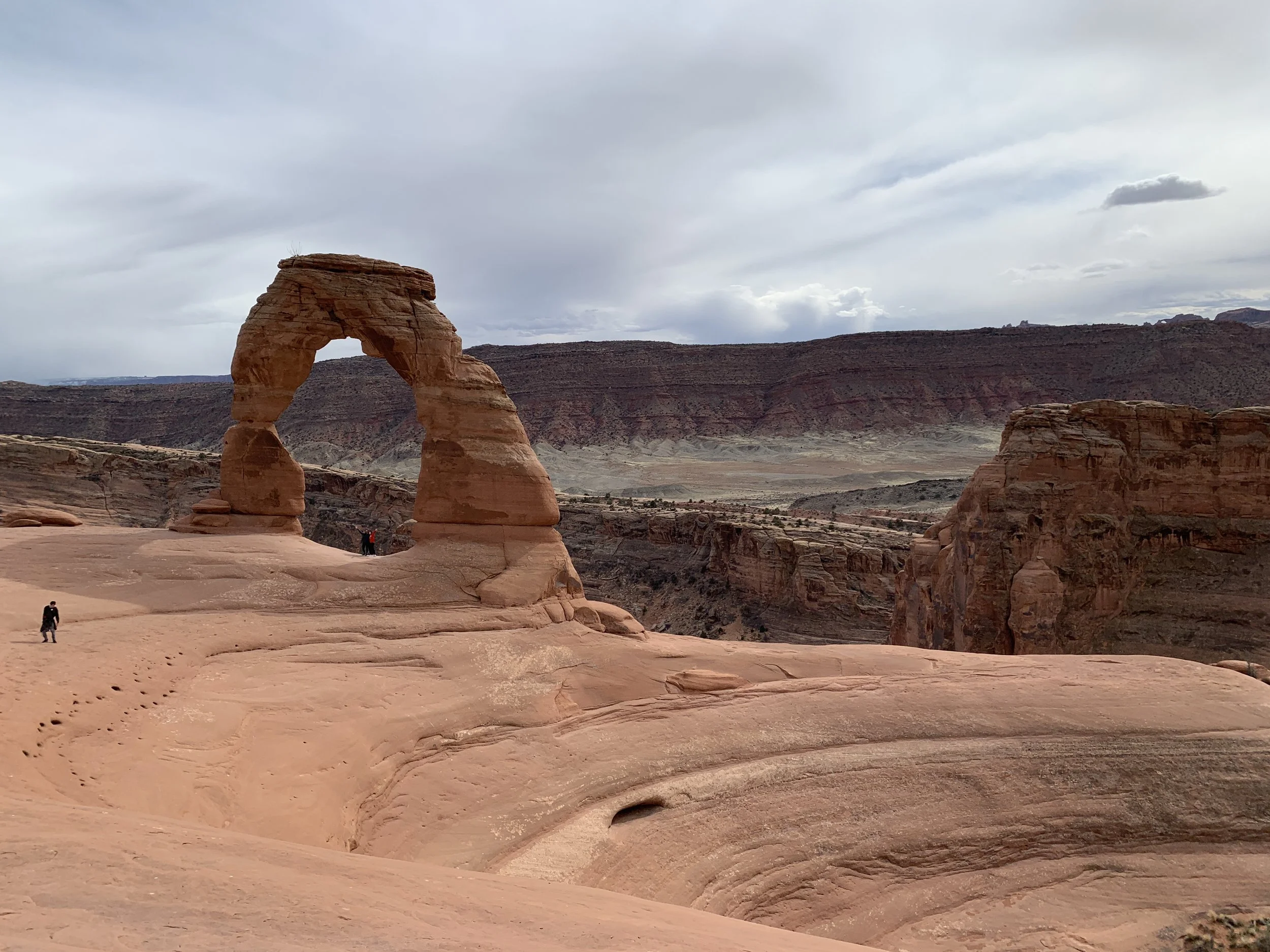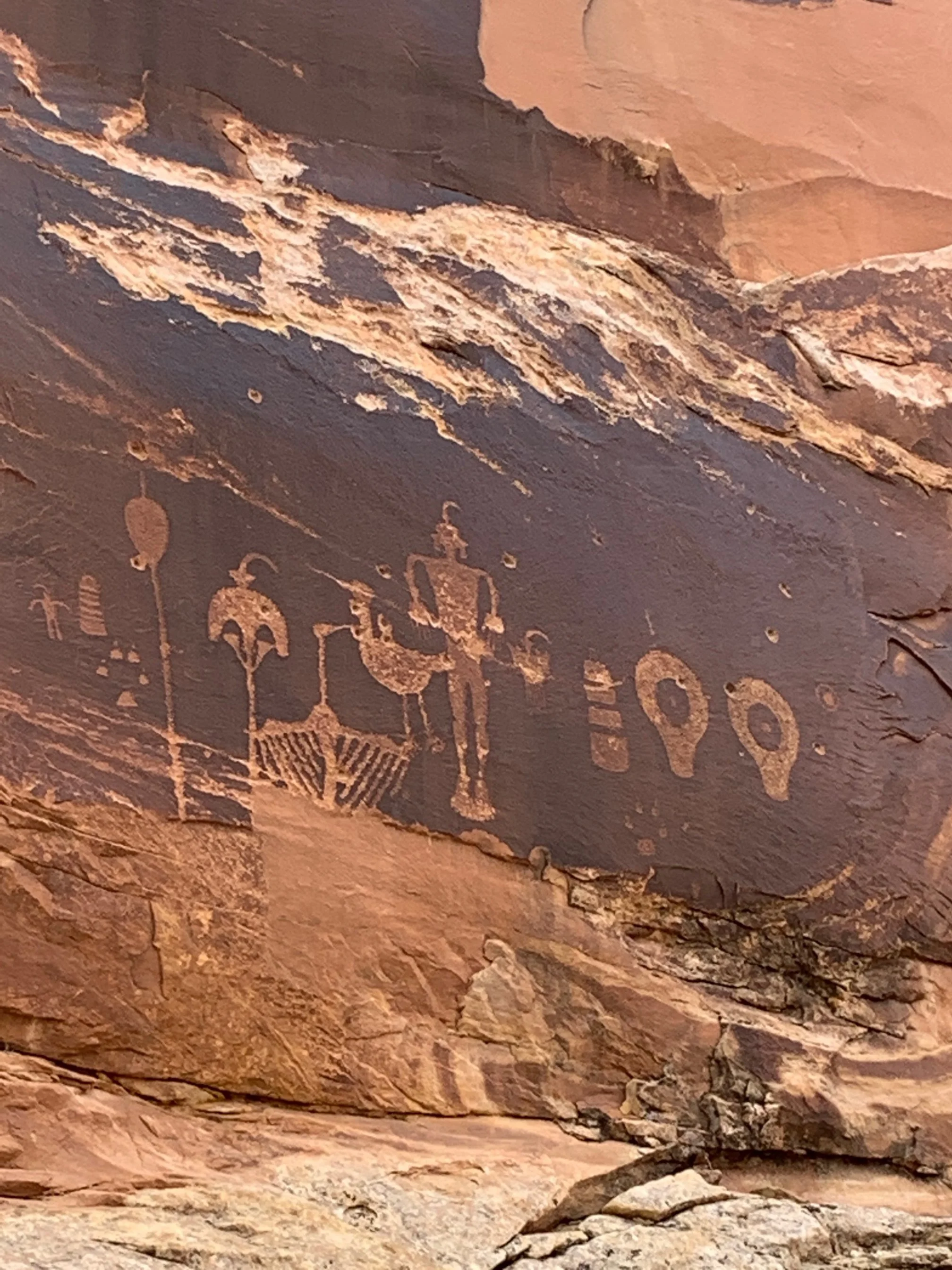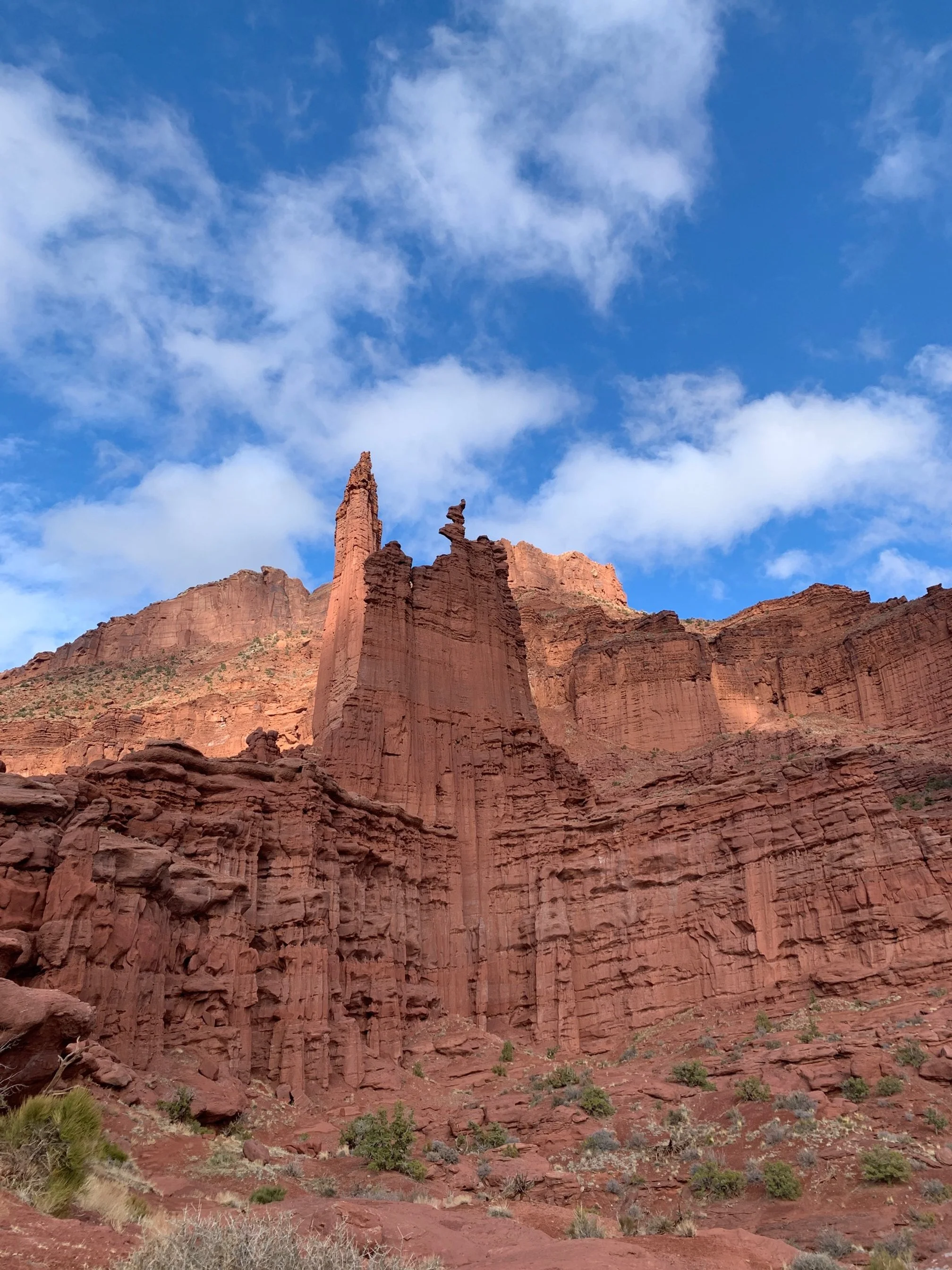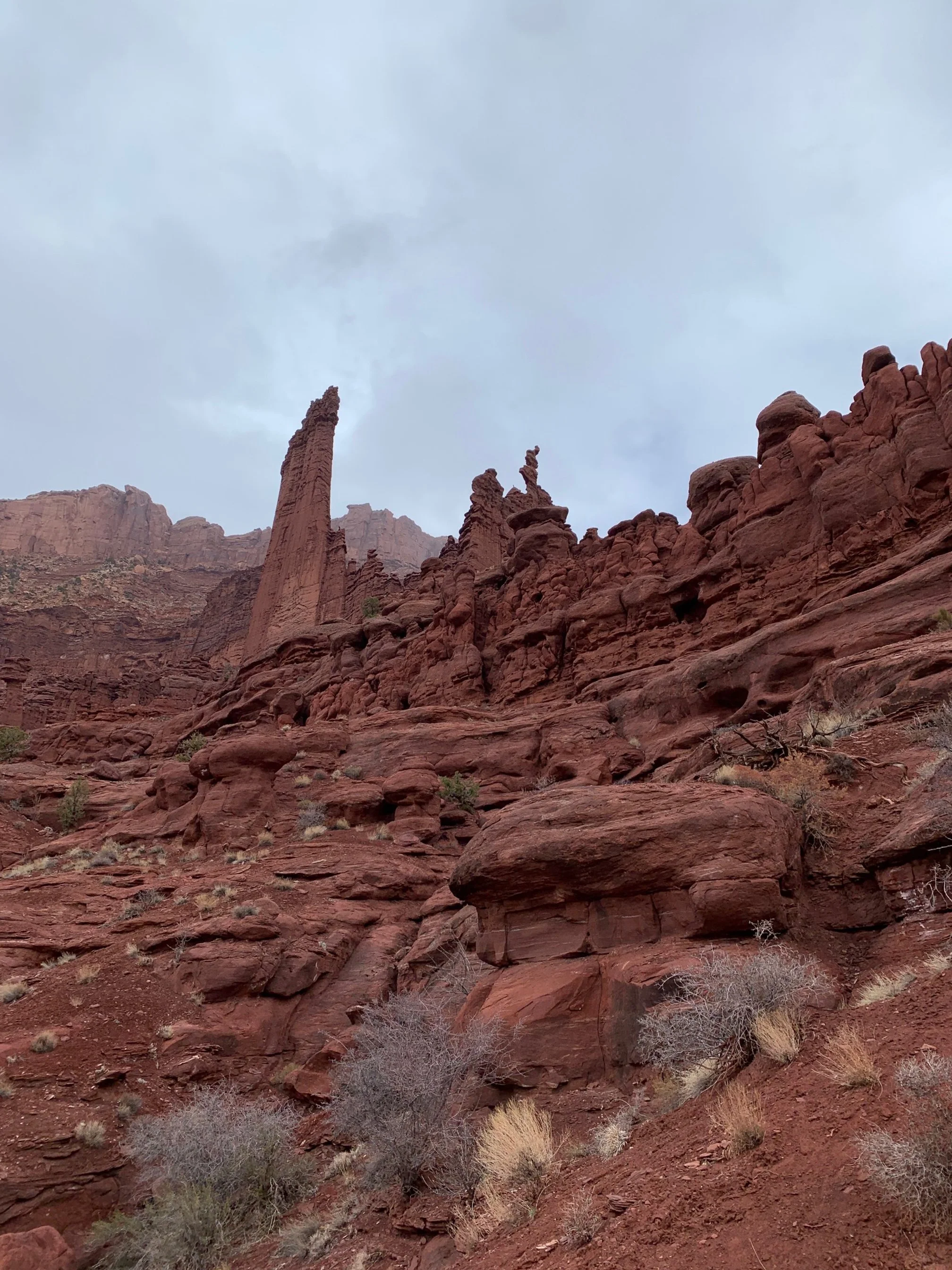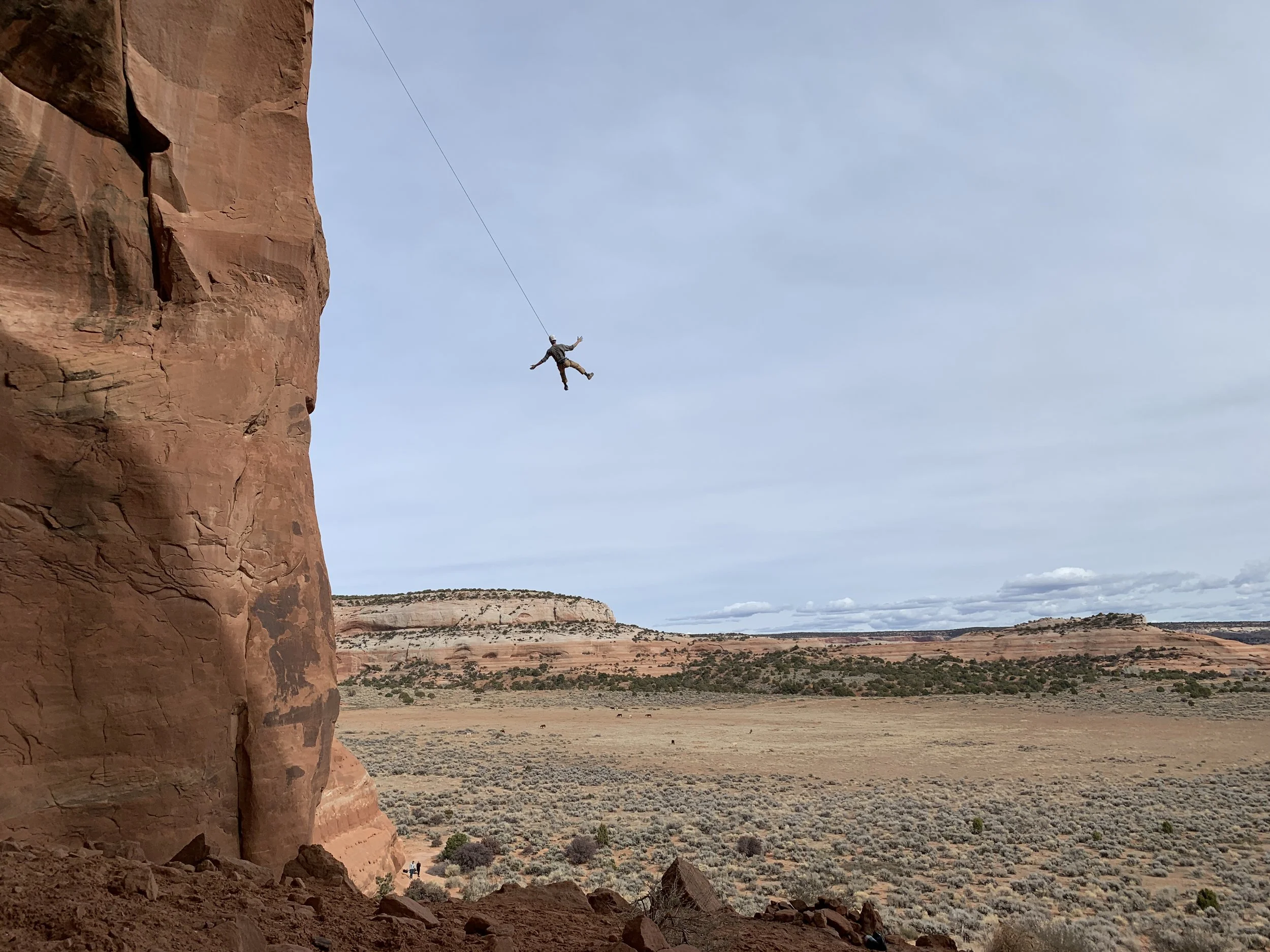Moab
Moab, Utah attracts people to its outdoor offerings. Climbing, hiking, base jumping, mountain biking and off-road enthusiasts swell to the area. Climbers and base-jumpers live the wandering nomadic life of the west. Their lives may be contained in a full-size van where they eat, sleep and live. Or they camp in areas where tents can be set up until the Bureau of Land Managment arrive telling them it is time to move on. Driving south along the Colorado River vans assemble along the road and climbers dot the canyon walls. Accessible, yet challenging brings climbers to this area where they can hone their skills and thrive on the adrenaline surge as they do so. The scenery is also spectacular, and they relish the views obtained climbing the canyon walls. For the observer, it is an easy place to watch for hours the multiple groups scaling the walls.
Further down the road, petroglyphs are viewable via short hikes. Birthing stone is popular for its many images that cover the rock faces. Other less well-known drawings and etchings on the stone are equally impressive with their many depictions of hunts, individuals and possessions. At times, considered art, the drawings and depictions record the indigenous peoples who travelled through and lived in this area. They also reflect a successful society, as the expression of art indicates a people who are prospering and have abundance to travel and able to express themselves art and drawings. Quite possible, they also provided messages to others identifying who they were, they had been there and where they may go next. The dry air has preserved these for us to see, wonder about and take us back to the time of the first peoples.
We follow in the present day those who roamed the area before us. Our places to visit manifest themselves in the national parks named Arches, Canyonlands, and Capital Reef. Arches is popular and fascinating to see the many geologic formations that give the park its name. Hiking trails abound that allow one to experience these formations up close. The millennium becomes apparent giving perspective to the time necessary to form the arches. Fortune also favors us that we can have these formations so accessible. While fundamentally formed the same way, they are also different when comparatively viewing Delicate Arch or Double Arch.
Complimenting the national parks are the Utah State parks. Goblin State Park is eerie with its hoodoo formations that proliferate as you walk through them. The tall thin spires of rock create a landscape that engages exploration. Colors abound in the formations with red orange filling the eye and streaks of burnt yellow running through the rock. One is drawn to how they were formed. To indigenous cultures they were formed by the creator and have taken on sacred significance. Geology tells us they are comprised of hard rock on top and softer rock down the spire which is continually being eroded by the sparse rainfall and winter freeze thaw cycle. Hence while we don’t see it, the formations are constantly changing, leading to the collapse of some spires and the formation of new ones. To us they appear as static stones which means permanence to us. Their formation also provides us with the subjective observation of being other worldly, giving us the opportunity to call them hoodoo’s.
Near Moab our adventures include 4-wheeling. This activity culminates every year during the Easter week Jeep Safari. People descend on Moab for a week of exploring the numerous trails that cater to the activity. It is also a time when 4-wheel clubs assemble once a year, allowing the renewal of old friendships. Socializing is the predominant activity, and equal time is spent in this pursuit and riding the trails. The latest and greatest accessories for one's vehicle are discussed and debated. New trails are explored. Moab is busy.
Our time through here is before the annual event with Moab preparing for the big week. Being early in the season allows us to find seats at restaurants and enjoy the 4-wheeling trails without the crowds. We rented a 4 seat Razr this year and Jeeps in the past. Our decision to go with the Razr is the ability of the vehicle to go almost anywhere. The low center of gravity, all-wheel drive, and easy maneuverability make it our choice. From observation, climbing slick rock walls that seem impassable is accomplished with the Razr. Climbing out of impossible sandstone holes by both Jeeps and Razr's is fascinating.
Our favorite trails are adjacent to town in the Sand Flats Recreation area. The area is also popular with mountain bikers and separate trails allow those to enjoy this sport. This day we elect to ride Hell’s Revenge, which is one of the most popular. It contains all the necessary elements during its all day 14-mile run. It also allows moderately skilled off-roaders such as us to bypass some of the difficult slot canyons. Experts drive these slots, yet not all the runs are successful. Roll-overs happen to create havoc with sheet metal and glass windshields. More perplexing is when a vehicle wedges between two rock faces after slipping between them. Tow straps, hand jacks and sometimes inflator bags appear in order to free the vehicle. Sometimes it takes hours to free up a vehicle. Once done the vehicle is usually drivable and the driver either continues or heads back to Moab to make repairs to ride the next day.
Hell’s revenge is filled with adrenaline, beautiful views, and the opportunity to talk with others who are on the trail. Walking to the Colorado River overlook is breathtaking and exhilarating as you approach yet stay distant from the sheer cliff edge. The river is a blue green ribbon winding its way through the red landscape and is accompanied by a highway looking like a black ribbon. Cars occasionally appear making their way down the road. Not much else is in your view, houses are non-existent nor is there any other type of commercial activity on the roadside. Enjoyable, we walk back to the Razr’s and later make our final descent back into Moab.
Hiking is for the next day, and we go east along the Colorado River Canyon to Fisher Towers trailhead. In the distance you see the spires. They are tall, thin and reach upwards. The hike-in brings you closer to appreciate the size and height of the Fishers. Deep red in color they overpower you with their size and walking among them is humbling. We are fortunate on this day not to have much trail traffic and allow ourselves to pause and take in the geology. As you go up trail, the valley opens in front of you and distance increases on the horizon. You are continually accompanied by the spires, and they become companions with you on the trail. Occasionally climbing aluminum ladders and hand ropes are encountered to guide you up the trail. Beauty keeps you moving and soon the realization is hours have passed and the sun is lowering to the horizon. You realize dusk is not too far away and with it will accompany the cooler evening temperatures. We make our turn back enjoying the lighting of rock in different ways as the sun descends. Dusk greets us at the trailhead as we climb back in the car.
Our end of week activity is a drive to Bluff, Utah near the Arizona state border. The landscape flattens out into a plateau with the occasional arch seen in the distance. Bluff was originally a Mormon settlement, and the local museum chronicles the first settlers experience coming from Salt Lake by wagon to the area. Remnants of their first houses are on site. The Navaho reservation is further south down the highway, and we it and off road to Petroglyphs that require a hike to view them along small canyon walls. You realize the protection from weather the cliffs provided to the inhabitants. Understanding begins to tell you why they stayed here with the small creek that flows at the bottom providing water and the shelter of the small canyon. Unknown is how long they stayed here, and was it seasonal or permanent for a while? These unknowns accompany you as you hike back out to the flatness of the valley above you.
We drive back from Bluff with a Utah State Geology guide in hand. Detailed by mile marker are formations of interest that created the landscape. Our interest is viewing arches, and they dot the landscape as we drive back north. A decision is made to take a side road and check out a rock outcropping containing an arch. To view the arch will require a short hike, and we are in hopes of being the only ones there once we climb the trail. Typical for this time of year in Utah, the sky is blue with a few clouds and temperatures are moderate. We enjoy our hike to the arch but learn we are not the only ones there. With us are a group of young rock climbers who have come down from Park City to free themselves from the snow. Some are at the top of the arch, and others are rigging a climbing rope and harness to swing out from a canyon wall next to the arch. We take a seat to watch this event and the first participant, a woman takes off from the wall and swings out. At the peak of the pendulum, she is probably 150 feet off the ground. Squeals of excitement fill the air as she swings back and forth. Eventually dissipating energy means she must be caught by another climber so she can be released from the harness. Once done, the harness and rope are hiked back up the canyon wall for the next participant.
Congenial, and full of youth, we spent the afternoon with the group. An offer is made for us to secure the harness around us and swing. Contemplation of the idea takes a while to consider. A typical cycle when considering endangering your life takes place. Okay – I will do it, followed by a pause of reconsideration and saying – I better not. After 2 or 3 of these iterations, we finally say no. Youth might tell us differently but with age caution creeps in to tell us the need for survival is higher. Thoughts about seeing one's children again rather than lying dead at the bottom of a canyon persuade us not to grab the harness rope. Also, the exuberance of youth is wonderful to watch. Risks to life seem low at their age and hence they spend the afternoon swinging through the blue Utah sky. To us it was a memorable afternoon, and we often go back to it and smile.
It is fitting that our drive back to Salt Lake City is a rainy day. Driving north the density of population joins us. Soon we will join the crowds at the airport as we walk to our plane. Sitting at the gate the Wasatch mountains are visible to the east. They frame Salt Lake and the valley below. The tabernacle is viewable and perceptibly sits above the city government and state government buildings. The city has grown along a north and south axis hemmed in by the Wasatch's to the east and the Great Salt Lake to the west. Provo and Ogden are now joined together by Salt Lake City. Tech has found the area adding to job and housing growth. Recreation including hiking, skiing and fly fishing add to the appeal of employment. Boise, Denver and smaller towns such as Jackson, Bozeman and Coeur d’ Alene join this list by attracting the active lifestyle and then retaining those who come to participate in it.
